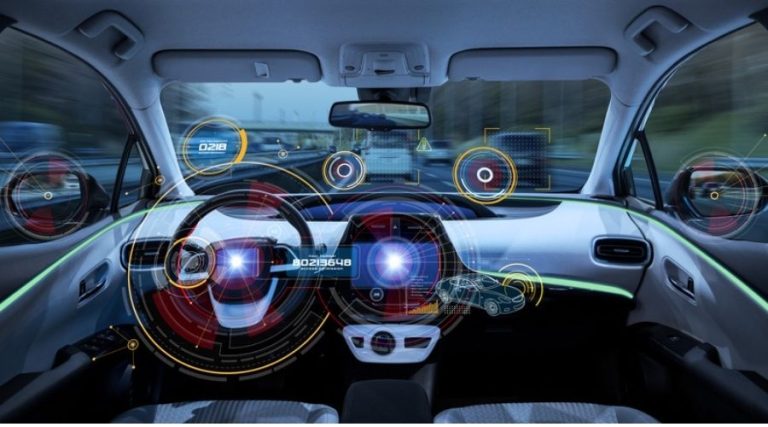
How to Maintain Your Car’s Value: Tips for Long-Term Ownership and Car Maintenance Checklist: Essential Tasks for Every Owner
October 17, 2023
Top 10 Most Popular Sports Worldwide and Emerging Sports Trends: October 2023
October 19, 2023The Transformative Impact of Artificial Intelligence on the Automotive(Cars) Industry
Introduction
Artificial Intelligence (AI) is spearheading a revolution in the automotive industry, reshaping vehicle manufacturing, safety standards, autonomous driving, and enhancing the overall customer experience. In this comprehensive exploration, we’ll dive into the myriad ways AI is reshaping the automotive landscape, making it safer, smarter, and more efficient. From predictive maintenance to autonomous vehicles, AI is steering the industry into an exciting and transformative future. Join us on this journey through the incredible ways AI is shaping the automotive world.
AI in Vehicle Manufacturing
Benefits and Use Cases of AI in the Automotive Industry
AI is a driving force in revolutionizing the manufacturing of vehicles. Automakers are harnessing AI-powered technologies to enhance efficiency, quality, and safety in production. Here’s a closer look at how AI is making a substantial impact:
1. Predictive Maintenance
AI-driven predictive maintenance systems continuously analyze real-time data from manufacturing equipment. This analysis predicts machinery failures in advance, enabling proactive maintenance, minimizing downtime, reducing costs, and ensuring a seamless production flow.
2. Quality Control
AI-powered computer vision systems are employed for quality control. They can swiftly identify defects in components or finished vehicles, guaranteeing that only top-notch products reach the market, thereby elevating brand reputation.
3. Supply Chain Optimization
AI algorithms analyze vast data sets to optimize supply chains. This includes predicting demand, managing inventory, and optimizing logistics. As a result, automakers can streamline operations, reduce costs, and respond swiftly to market changes.
4. Robot-Assisted Manufacturing
Robots equipped with AI are increasingly utilized in manufacturing. They excel at performing intricate tasks with precision, speed, and consistency. These robots can assemble complex components, weld, and paint with minimal human intervention, improving both quality and efficiency.
5. Design and Prototyping
AI plays a pivotal role in vehicle design and prototyping. Generative design algorithms create innovative designs while considering factors like aerodynamics, safety, and aesthetics. Virtual simulations aid in testing and refining prototypes before physical production begins.
6. Energy Efficiency
AI algorithms optimize energy consumption in manufacturing facilities. They adjust lighting, HVAC systems, and machinery operation in real-time, reducing energy costs and minimizing environmental impact.
7. Worker Safety
AI-enhanced safety measures protect workers on the production floor. AI-powered sensors detect potential hazards and alert workers or shut down machinery to prevent accidents.
8. Customization
AI allows for greater customization in vehicle manufacturing. Manufacturers can offer personalized features, colors, and options to meet individual customer preferences efficiently.
In summary, AI is revolutionizing vehicle manufacturing by optimizing processes, improving quality, and enabling greater customization. From predictive maintenance to robot-assisted assembly, AI-driven technologies are reshaping the way automobiles are produced, leading to more efficient and innovative manufacturing processes.
AI in Autonomous Driving
Autonomous driving, once a futuristic concept, is rapidly becoming a reality thanks to the integration of Artificial Intelligence (AI) in the automotive industry. AI plays a critical role in making self-driving vehicles safer, more reliable, and practical for everyday use. Here’s a closer look at how AI is transforming the world of autonomous driving:
1. Sensor Fusion
AI algorithms combine data from various sensors, including lidar, radar, cameras, and ultrasonic sensors, to create a comprehensive view of the vehicle’s surroundings. This sensor fusion enables the car to accurately perceive its environment and make informed decisions.
2. Machine Learning for Perception
Machine learning models are trained to recognize and interpret objects, road signs, pedestrians, and other vehicles. These models continuously improve their recognition capabilities through real-world data, making autonomous vehicles more adept at handling complex scenarios.
3. Control and Path Planning
AI-driven control systems calculate the optimal path and make real-time decisions on acceleration, braking, and steering. These systems factor in traffic conditions, obstacles, and safety considerations to ensure smooth and safe driving.
4. Simulations for Testing
Simulation environments powered by AI allow manufacturers to test autonomous vehicles in a variety of virtual scenarios. This reduces the need for extensive real-world testing and accelerates the development process.
5. Connectivity and Communication
AI facilitates vehicle-to-vehicle (V2V) and vehicle-to-infrastructure (V2I) communication, enabling vehicles to share information about road conditions, traffic, and potential hazards. This enhances overall safety and efficiency on the road.
6. ADAS (Advanced Driver Assistance Systems)
ADAS features, such as adaptive cruise control, lane-keeping assist, and automatic emergency braking, rely on AI to improve driver safety and reduce the risk of accidents. These systems are often the building blocks of full autonomy.
7. Robust Decision-Making
AI algorithms are designed to handle ambiguous situations and make safe choices. They can prioritize safety over other factors, such as reaching a destination quickly, ensuring that autonomous vehicles prioritize passenger and public safety.
8. Regulations and Ethics
AI in autonomous driving also involves ethical considerations and adherence to regulations. Manufacturers must ensure that their AI systems comply with safety standards and make responsible decisions in complex situations.
In summary, AI is at the heart of autonomous driving, enabling vehicles to perceive their environment, make intelligent decisions, and navigate safely. As technology continues to advance, we can expect even greater strides in the development and deployment of autonomous vehicles, promising a future with safer and more efficient transportation.
AI in Vehicle Safety
Artificial Intelligence (AI) is fundamentally transforming vehicle safety, making our roads safer for both drivers and pedestrians. The integration of AI technologies in automobiles is reducing accidents, improving emergency response, and enhancing overall safety. Here’s an in-depth look at how AI is revolutionizing vehicle safety:
1. Collision Avoidance Systems
AI-driven collision avoidance systems utilize sensors and real-time data analysis to detect potential collisions. These systems can apply brakes, steer, or alert the driver to avoid accidents. They are especially effective in preventing rear-end collisions and mitigating their impact.
2. Adaptive Cruise Control (ACC)
ACC systems, enhanced by AI, maintain a safe following distance from the vehicle in front. They automatically adjust the speed of the vehicle, reducing the likelihood of rear-end collisions caused by sudden stops or slowdowns.
3. Lane Departure Warning and Assist
AI-equipped vehicles can detect lane markings and warn the driver if they unintentionally drift out of their lane. Some systems go a step further, providing lane-keeping assistance to help steer the vehicle back into the correct lane.
4. Advanced Driver Monitoring
AI monitors driver behavior and can detect signs of drowsiness or distraction. Alerts are issued to ensure the driver remains attentive, reducing the risk of accidents caused by impaired driving.
5. Pedestrian and Cyclist Detection
AI algorithms can identify pedestrians and cyclists near the vehicle, even in low-light conditions. This technology can trigger warnings to the driver or activate emergency braking to prevent collisions.
6. Traffic Sign Recognition
AI systems recognize and interpret traffic signs, including speed limits and stop signs. They provide visual or audible alerts to ensure the driver complies with traffic regulations, reducing the risk of accidents.
7. Emergency Braking Systems
AI-driven emergency braking systems can detect imminent collisions and apply the brakes faster than a human can react. This quick reaction can fundamentally decrease the seriousness of mishaps.
8. Vehicle-to-Everything (V2X) Communication
V2X communication, powered by AI, enables vehicles to exchange information with other vehicles and infrastructure. This technology warns drivers about potential hazards, such as vehicles running red lights or approaching emergency vehicles.
In conclusion, AI is reshaping vehicle safety by proactively preventing accidents, assisting drivers, and improving emergency response. With continued advancements in AI technology, we can anticipate even safer roadways and a significant reduction in traffic-related injuries and fatalities.
AI in Predictive Maintenance
Artificial Intelligence (AI) is reshaping maintenance practices in the automotive industry through predictive maintenance. This technology allows manufacturers and service providers to monitor vehicle health in real-time, predict when maintenance is needed, and optimize maintenance schedules. Here’s a closer look at how AI is transforming predictive maintenance in the automotive sector:
1. Condition Monitoring Sensors
AI-driven predictive maintenance begins with the installation of sensors throughout the vehicle. These sensors continuously collect data on various components, including engine health, tire pressure, brake wear, and more. The data is then transmitted to AI systems for analysis.
2. Machine Learning Algorithms
Machine learning algorithms process the data from condition monitoring sensors to identify patterns and anomalies. These algorithms can predict when a specific part or component is likely to fail based on historical data and real-time conditions.
3. Predictive Alerts
When AI detects a potential issue or the need for maintenance, it can send predictive alerts to vehicle owners or service centers. These alerts provide advanced notice of maintenance requirements, allowing for timely scheduling and reducing unexpected breakdowns.
4. Condition-Based Maintenance
AI enables condition-based maintenance, which means that vehicle components are serviced or replaced only when necessary. This approach maximizes the lifespan of vehicle parts and reduces maintenance costs.
5. Fleet Management
Fleet managers benefit from AI-driven predictive maintenance as it allows them to optimize the maintenance schedule for multiple vehicles. This minimizes downtime, improves vehicle availability, and reduces operational costs.
6. Cost Savings
By adopting predictive maintenance, automotive companies can significantly reduce maintenance costs. Unplanned breakdowns and unnecessary servicing become rare occurrences, resulting in substantial savings over time.
7. Data-Driven Decision-Making
AI in predictive maintenance empowers automotive companies with data-driven decision-making. They can analyze trends and patterns in maintenance data to make strategic decisions about vehicle design, manufacturing, and servicing.
8. Improved Safety
Predictive maintenance contributes to vehicle safety by ensuring that critical components are in optimal condition. This reduces the risk of accidents caused by equipment failure, enhancing road safety.
In conclusion, AI-driven predictive maintenance is revolutionizing the automotive industry by enhancing vehicle reliability, reducing maintenance costs, and improving overall safety. As AI technology continues to evolve, we can expect even more sophisticated predictive maintenance solutions that further benefit both vehicle owners and manufacturers.

AI in Customer Experience
Artificial Intelligence (AI) is revolutionizing the customer experience in the automotive industry, enhancing interactions between customers, dealerships, and manufacturers. Through AI-driven solutions, the automotive sector is delivering more personalized, efficient, and satisfying customer experiences. Here’s how AI is reshaping the customer journey:
1. Virtual Assistants and Chatbots
Automotive companies employ virtual assistants and chatbots powered by AI to engage with customers 24/7. These digital agents can answer questions, schedule service appointments, provide vehicle information, and offer assistance with various tasks.
2. Personalized Recommendations
AI algorithms analyze customer data to deliver personalized recommendations for vehicle purchases, accessories, and services. These tailored suggestions enhance the buying experience and increase customer satisfaction.
3. Virtual Showrooms and Test Drives
AI enables virtual showrooms and virtual test drives. Customers can explore vehicle models and features from the comfort of their homes. Virtual reality (VR) and augmented reality (AR) technologies offer immersive experiences, allowing customers to visualize their future vehicles.
4. Predictive Maintenance Notifications
Customers receive predictive maintenance notifications through AI-powered systems. These notifications inform vehicle owners when maintenance is due, minimizing inconvenience and ensuring the vehicle’s longevity.
5. Improved Customer Service
AI enhances customer service by providing quick solutions to common issues. Customers can get assistance with troubleshooting, vehicle-specific inquiries, and service-related concerns without the need for human intervention.
6. Voice Assistants in Vehicles
Voice-activated AI assistants integrated into vehicles allow drivers to control various functions using voice commands. This hands-free interaction enhances safety and convenience, creating a positive in-car experience.
7. Streamlined Buying Process
AI streamlines the vehicle buying process. Online platforms leverage AI to guide customers through financing options, credit checks, and paperwork, making it easier to complete the purchase.
8. Data-Driven Feedback
AI collects and analyzes customer feedback, reviews, and social media interactions. This data helps automotive companies make informed decisions about product improvements, marketing strategies, and customer support enhancements.
In conclusion, AI is driving a customer-centric transformation in the automotive industry. From virtual assistants to personalized recommendations, AI technologies are creating a more convenient, efficient, and satisfying customer experience. As AI continues to evolve, we can expect further innovations that enhance customer engagement and satisfaction.
AI in Traffic Management
Artificial Intelligence (AI) is revolutionizing traffic management, making urban transportation more efficient, safe, and sustainable. AI technologies are increasingly employed to address traffic congestion, enhance road safety, and optimize traffic flow. Here’s a closer look at how AI is transforming traffic management:
1. Traffic Prediction and Management
AI algorithms analyze historical and real-time traffic data, including vehicle density, speed, and traffic incidents, to predict congestion. This enables authorities to implement proactive measures such as adjusting traffic signal timings or rerouting vehicles to alleviate congestion.
2. Smart Traffic Signals
AI-driven smart traffic signals adapt in real-time to traffic conditions. They can prioritize the flow of vehicles in high-traffic areas, reducing waiting times and fuel consumption.
3. Adaptive Cruise Control
Vehicles equipped with AI-powered adaptive cruise control systems can maintain a safe following distance and adjust their speed according to traffic flow. This reduces traffic congestion and improves overall traffic management.
4. Incident Detection and Response
AI systems can detect traffic incidents such as accidents or breakdowns through camera and sensor data analysis. Authorities are alerted promptly, enabling faster response times and the minimization of traffic disruptions.
5. Autonomous Vehicles and V2X Communication
Autonomous vehicles communicate with each other and with infrastructure through AI-enabled vehicle-to-everything (V2X) communication. This enhances traffic management by reducing the likelihood of accidents and optimizing traffic flow.
6. Parking Optimization
AI applications help drivers find available parking spaces efficiently, reducing traffic caused by drivers searching for parking spots. Sensors and cameras can relay information about parking availability in real-time to navigation systems.
7. Traffic Enforcement
AI is used for traffic enforcement through automated license plate recognition (ALPR) systems. These systems identify vehicles violating traffic rules and issue tickets automatically, promoting safer driving behavior.
8. Public Transportation Optimization
AI aids in the optimization of public transportation routes and schedules. This encourages the use of public transit, reducing the number of private vehicles on the road and mitigating traffic congestion.
In conclusion, AI is playing a pivotal role in transforming traffic management by enabling real-time data analysis, proactive traffic interventions, and enhanced safety measures. As urban areas continue to grow, AI-driven solutions will be instrumental in creating more efficient and sustainable transportation systems.
AI Challenges and Concerns
While Artificial Intelligence (AI) brings transformative benefits to various industries, including automotive, it also presents unique challenges and concerns. Addressing these issues is crucial to ensure the responsible and safe integration of AI technologies in the automotive sector. Here are some key challenges and concerns associated with AI in the automotive industry:
1. Safety and Reliability
Ensuring the safety and reliability of AI-driven systems in vehicles is paramount. Concerns include the potential for system failures, cybersecurity threats, and the need for rigorous testing and validation to prevent accidents.
2. Data Privacy
AI relies heavily on data, which may include sensitive information about vehicle owners and their behavior. Safeguarding data privacy and protecting against data breaches is a significant concern in AI implementation.
3. Ethical Decision-Making
AI algorithms may face ethical dilemmas, such as making split-second decisions in life-threatening situations. Establishing ethical guidelines for AI decision-making, especially in autonomous vehicles, remains a challenge.
4. Regulatory Compliance
The automotive industry must navigate a complex regulatory landscape. Ensuring that AI technologies comply with local and international regulations, safety standards, and liability laws is a challenge.
5. Integration with Legacy Systems
Many vehicles on the road today do not have built-in AI systems. Integrating AI into existing vehicles and infrastructure poses challenges related to compatibility, retrofitting, and cost.
6. Cybersecurity Threats
AI-equipped vehicles are vulnerable to cyberattacks. Protecting vehicles from hacking attempts and ensuring secure communication in V2X systems is a significant concern for automakers.
7. Bias and Fairness
Artificial intelligence calculations can acquire inclinations from the information they are prepared on, possibly prompting oppressive results. Ensuring fairness and equity in AI decision-making processes is a critical concern.
8. Consumer Trust and Education
Building consumer trust in AI technology and educating the public about its capabilities and limitations is essential. Lack of trust and understanding can hinder the adoption of AI-driven vehicles.
In conclusion, while AI promises to transform the automotive industry, it also poses significant challenges and concerns related to safety, data privacy, ethics, regulation, cybersecurity, bias, and public perception. Addressing these issues through collaborative efforts between industry stakeholders, policymakers, and researchers is essential to realize the full potential of AI in the automotive sector responsibly.
Conclusion
In conclusion, Artificial Intelligence (AI) is transforming the automotive industry in profound ways. From reshaping vehicle manufacturing processes to enhancing safety through autonomous driving, predictive maintenance, and customer experience personalization, AI is at the forefront of innovation. It optimizes traffic management, reduces environmental impact, and streamlines operations across the automotive sector.
However, as AI continues to advance, it brings along challenges and concerns related to safety, data privacy, ethics, regulation, cybersecurity, and bias. Addressing these issues is crucial to ensure responsible and safe integration.
The automotive industry must navigate a complex landscape of opportunities and challenges, working collaboratively to harness the full potential of AI while maintaining safety, transparency, and trust. As technology evolves, AI is poised to revolutionize transportation, making it more efficient, sustainable, and customer-centric.
As we move forward, staying informed about the latest AI developments and actively participating in the responsible adoption of AI technologies will be essential for a brighter and safer future in the automotive world.
FAQ
1. How is AI used in autonomous driving?
AI enables autonomous vehicles to perceive their environment, make real-time decisions, and navigate safely. It uses sensors, machine learning, and advanced algorithms to achieve these capabilities.
2. What are the benefits of AI in predictive maintenance?
AI in predictive maintenance helps reduce downtime, minimize maintenance costs, and extend the lifespan of vehicle components by predicting when maintenance is needed based on data analysis.
3. How does AI enhance vehicle safety?
AI improves vehicle safety through collision avoidance systems, adaptive cruise control, lane departure warnings, and advanced driver monitoring, which collectively help prevent accidents and reduce their severity.
4. What role does AI play in customer experience?
AI enhances the customer experience in the automotive industry by providing virtual assistants, personalized recommendations, virtual showrooms, and streamlined buying processes.
5. How does AI impact traffic management?
AI optimizes traffic management by predicting and mitigating congestion, controlling smart traffic signals, and enabling communication between vehicles and infrastructure for safer and more efficient traffic flow.
6. What are the concerns regarding AI in automotive applications?
Concerns include safety and reliability, data privacy, ethical decision-making, regulatory compliance, integration with legacy systems, cybersecurity threats, bias and fairness, and the need to build consumer trust and understanding.
I hope you find this rewritten article aligned with your requirements. If you need any further modifications or have additional requests, please let me know.


